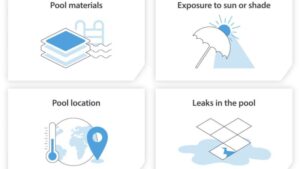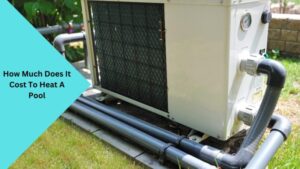Are you considering adding a pool to your backyard oasis or seeking ways to better manage your current pool expenses? One critical aspect you mustn’t overlook is the cost of heating your pool. While the notion of a comfortably warm pool is undeniably enticing, it’s essential to understand the financial implications that come with pool heating. In this comprehensive guide, we’ll break down the costs associated with heating a pool and explore different heating methods, factors affecting expenses, additional costs, and strategies to lower them. So, let’s dive in and unravel the mysteries of pool heating costs!
The Different Pool Heating Options and Their Costs
When it comes to heating your pool, various options are available, each with its own benefits and costs. Let’s explore the most common pool heating methods, along with their associated expenses.
2.1. Heating a Pool with Gas: Breaking Down the Expenses
Gas heating is a popular choice for pool owners due to its ability to heat pools quickly. However, it’s important to be aware of the costs involved. On average, the cost of heating a pool with gas can range from $300 to $1,500 per month, depending on factors such as pool size, local gas prices, and desired temperature. The initial setup costs can also be significant since a gas heating system typically requires a heater unit, gas line connections, and professional installation.
To ensure efficient gas usage and reduce costs, consider installing a pool cover to retain heat and minimize heat loss due to evaporation. Additionally, regular maintenance and inspections of your gas heating system can keep it running optimally and prevent any potential costly issues.
2.2. The Cost of Heating a Pool with Electric Heat Pumps
Another popular option for pool heating is electric heat pumps. These pumps operate by extracting heat from the air and transferring it to the pool water, making them more energy-efficient than gas heaters. While the initial investment for an electric heat pump may be higher than a gas heater, the operational costs tend to be lower.
On average, the monthly cost of heating a pool with an electric heat pump can range from $100 to $500, depending on factors such as pool size, desired temperature, and local electricity rates. It’s worth noting that electric heat pumps may take longer to heat the pool compared to gas heaters, so planning ahead and monitoring the pool’s temperature is essential to optimize energy usage and costs.
2.3. Solar Pool Heating: A Budget-Friendly Alternative
If you’re searching for a cost-effective and environmentally friendly way to heat your pool, solar pool heating could be the perfect solution. Solar heating systems utilize the sun’s energy to warm the pool water, reducing reliance on traditional energy sources.here is complete article about How Much Do Solar Pool Heaters Cost? A Comprehensive Guide
The initial cost of installing a solar pool heating system can range from $3,000 to $8,000, depending on factors such as pool size, solar collector size, and system complexity. However, once installed, solar heating systems can significantly reduce monthly operational costs, as they primarily rely on free solar energy. The exact cost savings will vary depending on factors like local solar exposure and climate.
2.4. Geothermal Pool Heating: Efficient but Pricey
Geothermal pool heating may not be as common as other methods, but it offers excellent energy efficiency and lower operating costs in the long run. Geothermal systems utilize the heat from the ground to warm the pool water, making them highly efficient and eco-friendly.
The cost of installing a geothermal pool heating system can range from $10,000 to $25,000, depending on factors such as soil conditions, drilling depth, and pool size. However, the monthly operational costs can be noticeably lower compared to gas or electric heating methods. Although geothermal pool heating requires a higher upfront investment, the long-term cost savings and energy efficiency make it an attractive option for those committed to sustainability.
2.5. Comparing the Costs: Pros and Cons of Each Heating Method
Each pool heating method comes with its own set of advantages and disadvantages. To help you make a well-informed decision, let’s compare the costs, benefits, and considerations for each option.
| Pool Heating Method | Average Monthly Cost | Initial Setup Cost | Key Considerations |
|---|---|---|---|
| Gas Heating | $300 – $1,500 | High | Quick heating, high operational cost, regular maintenance |
| Electric Heat Pumps | $100 – $500 | Moderate | Energy-efficient, longer heating time, monitor temperature |
| Solar Pool Heating | Varies significantly | Moderate | Environmentally friendly, lower operational costs, solar exposure |
| Geothermal Heating | Varies significantly | High | Energy-efficient, high initial cost, long-term savings, drilling depth |
Consider your budget, preferences, and long-term goals when choosing the heating method that suits you best. By aligning your needs with the features of each option, you can make a decision that will keep both your pool and wallet happy.
Factors Influencing Pool Heating Expenses

Several factors can significantly impact the cost of heating your pool. Understanding these factors will help you estimate expenses more accurately and make informed decisions regarding heating methods. Let’s delve into the key influencers of pool heating costs.
3.1. Pool Size, Shape, and Depth
The size, shape, and depth of your pool have a direct impact on the heating cost. As a general rule, larger pools require more energy and time to heat, resulting in higher expenses. Similarly, irregular pool shapes or those with deeper sections will have a greater volume of water to heat, contributing to increased heating costs. In contrast, smaller and shallower pools usually require less energy and time for heating.
When planning for a new pool, considering the size, shape, and depth can help you make an informed choice that aligns with your budget and heating preferences. For existing pools, optimizing heat retention through insulation and covers can help reduce costs.
3.2. Average Daily Temperature and Warm-up Time
The average daily temperature, especially during the colder months, plays a crucial role in determining heating costs. If you live in an area with a colder climate, you may need to invest more in energy to maintain your desired pool temperature. Additionally, if you prefer to frequently use your pool during colder months, the warm-up time will impact your energy consumption and, consequently, your heating costs.
By understanding these weather-related factors, you can plan your pool usage and adjust your heating strategy accordingly. This could involve heating the pool only on days when you plan to use it or investing in energy-efficient heating methods that can handle colder temperatures more effectively.
3.3. Location and Climate Considerations
The geographic location of your pool has a significant influence on heating costs. Warmer areas with mild climates may require less energy to heat the pool compared to colder regions. Additionally, the number of sunny days, solar exposure, and prevailing winds in your location can impact the effectiveness of solar heating systems.
Consider the local climate, weather patterns, and available sunlight when selecting a heating method. Choosing a solution well-suited to your specific location can result in substantial cost savings over time.
Additional Costs Associated with Pool Heating
Aside from the primary heating expenses discussed, there are additional costs to be aware of when it comes to heating your pool. Let’s explore a few common costs that pool owners may encounter.
4.1. Vinyl Liner Pool Conversion Costs
If you own a vinyl liner pool and want to switch to a different heating method, such as solar or geothermal, you may incur additional costs. The conversion process involves removing the vinyl liner, preparing the pool’s surface for the new heating system, and installing the necessary components.here is complete article for you about How Much Does It Cost To Convert A Vinyl Liner Pool To A Gunite Pool?
Vinyl liner pool conversion costs can vary depending on factors such as pool size, chosen heating method, and any necessary renovations. It’s recommended to consult with pool professionals to assess your specific situation and obtain accurate cost estimates.
4.2. Replacing Pool Lights: How Much Does It Cost?
Maintaining a well-lit pool is essential for safety and ambiance. If you’re considering replacing your pool lights, it’s important to consider the associated costs The cost of pool light replacement can vary depending on factors such as the type and quality lights, installation fees, and any necessary electrical work.
On average, the cost to replace a pool light ranges from $200 to $800. However, it’s always recommended to obtain quotes from trusted professionals to get a precise estimate based on your specific requirements.
4.3. Winter Pool Heating: A Special Challenge
Heating your pool during the winter season brings its own set of challenges and considerations. The colder temperatures and increased heat loss require additional energy and potentially higher heating costs. Pool owners living in regions with harsh winters may need to explore supplementary heating options or adjust their heating strategies to ensure their pool water remains at a comfortable temperature.
Before winter arrives, assess your pool’s insulation, covers, and other aspects that affect heat retention. Implementing appropriate measures to minimize heat loss can help reduce heating costs during the winter months.
Strategies to Lower Pool Heating Costs
While heating a pool can incur significant expenses, there are strategies you can employ to reduce these costs. Let’s explore some effective ways to optimize your pool heating efficiency.
5.1. Insulate Your Pool to Retain Heat
Proper insulation plays a crucial role in minimizing heat loss and reducing heating costs. Consider insulating your pool to retain heat more effectively. This can be achieved through the use of insulating pool covers, thermal blankets, or solar rings. These insulating solutions prevent heat from escaping as quickly, resulting in energy savings and lower heating costs.
5.2. Use a Pool Cover for Improved Heat Retention
Using a pool cover is one of the most effective ways to reduce heat loss and energy consumption. When not in use, covering your pool with a well-fitting pool cover prevents heat evaporation, reduces debris accumulation, and retains warmth. As a result, you will require less energy to heat the pool, leading to significant cost savings over time.
5.3. Optimize Heating System Efficiency
Regular maintenance and proper upkeep of your pool heating system play a crucial role in ensuring optimal efficiency. Schedule professional inspections and cleanings to identify and address any potential issues that may impact your system’s performance. A well-maintained heating system operates more efficiently, reducing energy consumption and lowering operational costs.
5.4. Consider Time-of-Use Electricity Rates
If you use an electric heat pump to heat your pool, familiarize yourself with time-of-use (TOU) electricity rates. TOU rates offer different pricing tiers depending on the time of the day. By using your electric heat pump during off-peak hours, when electricity rates are lower, you can save significantly on your monthly energy bills.
Consult with your energy provider to understand the available TOU plans and determine how they can benefit your pool heating costs.
Conclusion:
Heating a pool can be a significant investment, but understanding the costs associated with it allows you to make informed decisions that align with your pool preferences and budget. By exploring different pool heating methods, considering factors impacting expenses, staying mindful of additional costs, and implementing strategies to lower heating costs, you can effectively manage your pool heating expenses while enjoying the comfort of a warm pool.
Remember to assess your pool’s size, shape, and depth, as well as the local climate and average daily temperature, to estimate your heating costs accurately. Additionally, explore alternative heating methods such as solar or geothermal, which can offer energy-efficient and cost-saving solutions in the long term. By implementing energy-saving strategies, optimizing system efficiency, and leveraging time-of-use electricity rates, you can further reduce your pool heating expenses.
So, take these insights to heart and dive into the world of pool heating costs with confidence. Make choices that balance your comfort, budget, and environmental footprint to create a warm and inviting pool experience all year round.

Greetings, fellow pool enthusiasts! I’m Turner Davis, your dedicated guide to the world of pool care and maintenance. With over a decade of experience in the field, I’ve made it my mission to transform ordinary pools into extraordinary aquatic retreats.

